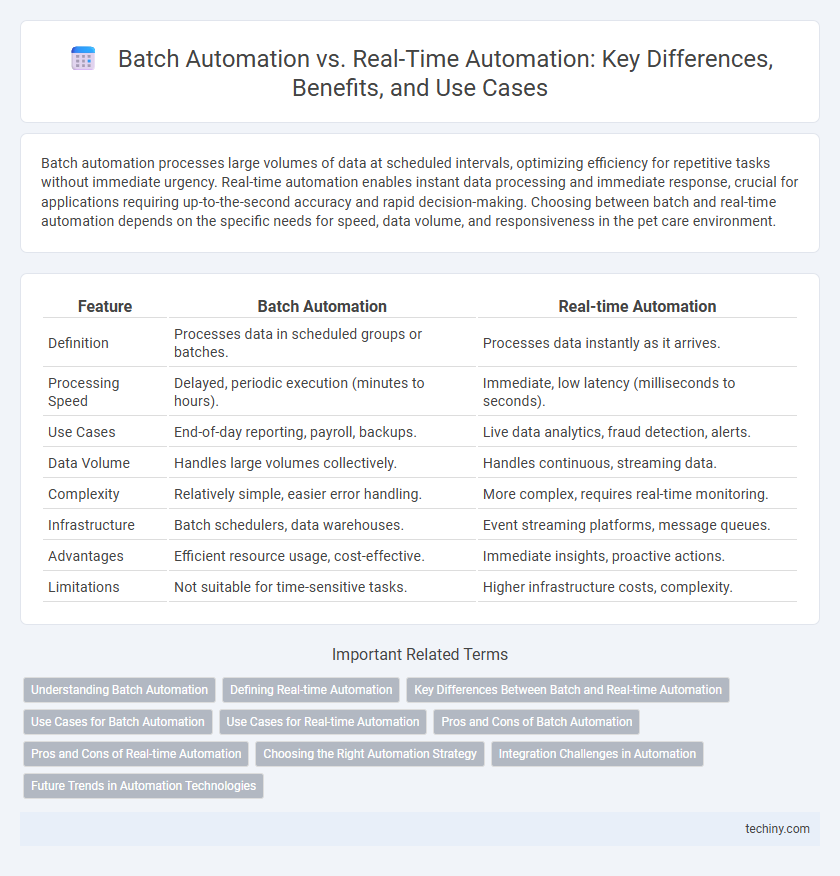Batch automation processes large volumes of data at scheduled intervals, optimizing efficiency for repetitive tasks without immediate urgency. Real-time automation enables instant data processing and immediate response, crucial for applications requiring up-to-the-second accuracy and rapid decision-making. Choosing between batch and real-time automation depends on the specific needs for speed, data volume, and responsiveness in the pet care environment.
Table of Comparison
| Feature | Batch Automation | Real-time Automation |
|---|---|---|
| Definition | Processes data in scheduled groups or batches. | Processes data instantly as it arrives. |
| Processing Speed | Delayed, periodic execution (minutes to hours). | Immediate, low latency (milliseconds to seconds). |
| Use Cases | End-of-day reporting, payroll, backups. | Live data analytics, fraud detection, alerts. |
| Data Volume | Handles large volumes collectively. | Handles continuous, streaming data. |
| Complexity | Relatively simple, easier error handling. | More complex, requires real-time monitoring. |
| Infrastructure | Batch schedulers, data warehouses. | Event streaming platforms, message queues. |
| Advantages | Efficient resource usage, cost-effective. | Immediate insights, proactive actions. |
| Limitations | Not suitable for time-sensitive tasks. | Higher infrastructure costs, complexity. |
Understanding Batch Automation
Batch automation processes large volumes of data collected over a period, executing tasks at scheduled intervals to optimize system resources and efficiency. This method suits operations like payroll processing, report generation, and data backups where immediate response is non-critical. By grouping tasks, batch automation reduces manual intervention, enhances consistency, and minimizes operational costs for repetitive, high-volume workflows.
Defining Real-time Automation
Real-time automation refers to the continuous, immediate processing of data and tasks as events occur, enabling instant decision-making and response. Unlike batch automation, which processes data in large groups at scheduled intervals, real-time automation ensures low latency and high responsiveness essential for applications like fraud detection, autonomous vehicles, and live monitoring systems. This approach leverages event-driven architectures and streaming technologies to maintain optimal operational efficiency and accuracy.
Key Differences Between Batch and Real-time Automation
Batch automation processes large volumes of data at scheduled intervals, optimizing system efficiency by handling tasks in groups during off-peak hours. Real-time automation executes tasks instantly as events occur, enabling immediate response and continuous data processing critical for dynamic environments. The primary difference lies in timing and data handling, with batch focusing on high-throughput processing and real-time emphasizing low-latency, event-driven actions.
Use Cases for Batch Automation
Batch automation excels in scenarios involving large volumes of data processed during off-peak hours, such as payroll processing, billing systems, and data migration tasks. It maximizes efficiency by executing repetitive tasks without human intervention, reducing errors and operational costs. Industries like finance, healthcare, and telecommunications benefit from batch automation to handle end-of-day reporting, inventory updates, and regulatory compliance workflows.
Use Cases for Real-time Automation
Real-time automation excels in use cases requiring immediate data processing and instant decision-making, such as fraud detection in financial transactions, dynamic pricing in e-commerce, and real-time customer support chatbots. This approach ensures systems respond swiftly to events as they occur, improving operational efficiency and customer experience by minimizing latency. Industries leveraging IoT sensors, stock trading platforms, and live social media monitoring benefit significantly from real-time automation's ability to handle continuous, high-velocity data streams.
Pros and Cons of Batch Automation
Batch automation processes large volumes of data collectively at scheduled intervals, offering efficiency in handling repetitive tasks without requiring continuous system engagement. This method reduces system resource consumption during peak hours and simplifies error handling by processing data in defined groups. However, batch automation lacks immediate response capabilities, making it unsuitable for time-sensitive applications that demand real-time data processing or instant decision-making.
Pros and Cons of Real-time Automation
Real-time automation enables instantaneous processing and immediate decision-making, enhancing responsiveness and operational efficiency in dynamic environments such as financial trading and customer support. However, it demands greater computational resources and more complex infrastructure, leading to higher implementation and maintenance costs. Despite these challenges, its ability to provide up-to-the-second data accuracy and reduce latency makes it essential for time-sensitive applications.
Choosing the Right Automation Strategy
Batch automation processes large volumes of data at scheduled intervals, optimizing efficiency for tasks like data aggregation and report generation. Real-time automation executes actions instantaneously, essential for time-sensitive operations such as fraud detection and live inventory updates. Selecting the right automation strategy depends on factors like data volume, processing urgency, and business goals to maximize operational effectiveness and resource allocation.
Integration Challenges in Automation
Batch automation often faces integration challenges due to its reliance on processing large volumes of data at scheduled intervals, causing delays in system synchronization and data consistency. Real-time automation requires seamless integration with streaming data sources and low-latency communication protocols, which can complicate interoperability between disparate systems. Both approaches demand robust API management, middleware solutions, and scalable infrastructure to handle diverse data formats and ensure reliable data flow across heterogeneous automation platforms.
Future Trends in Automation Technologies
Future trends in automation technologies emphasize the integration of AI-driven predictive analytics to enhance both batch automation and real-time automation processes. Edge computing and 5G connectivity enable real-time automation systems to handle massive data streams with minimal latency, optimizing decision-making in industries such as manufacturing and logistics. Batch automation will evolve by incorporating machine learning models that improve scheduling efficiency and resource allocation across large-scale operations.
Batch Automation vs Real-time Automation Infographic

 techiny.com
techiny.com